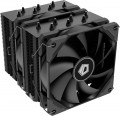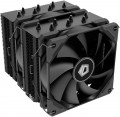Heatpipe contact
The type of contact between the heat pipes provided in the heatsink of the cooling system and the cooled components (usually the CPU). For more information about heat pipes, see above, and the types of contact can be as follows:
—
Indirect. The classic version of the design: heat pipes pass through a metal (usually aluminium) base, which is directly adjacent to the surface of the chip. The advantage of such contact is the most even distribution of heat between the tubes, regardless of the physical size of the chip itself (the main thing is that it should not be larger than the sole). At the same time, the extra piece between the processor and the tubes inevitably increases thermal resistance and slightly reduces the overall cooling efficiency. In many systems, especially high-end ones, this drawback is compensated by various design solutions (primarily by the tightest connection of the tubes with the sole), but this, in turn, affects the cost.
—
Direct. With direct contact, the heat pipes fit directly on the cooled chip, without an additional sole; for this, the surface of the tubes on the desired side is ground down to a plane. Due to the absence of intermediate parts, the thermal resistance at the places where the tubes fit is minimal, and at the same time, the radiator design itself is simpler and cheaper than with indirect contact. On the other hand, there are gaps between the heat
...pipes, sometimes very large — as a result, the surface of the serviced chip is cooled unevenly. This is partly offset by the presence of a substrate (in this case, it fills these gaps) and the use of thermal paste, however, in terms of uniformity of heat removal, direct contact is still inevitably inferior to indirect contact. Therefore, this option is found mainly in inexpensive coolers, although it can also be used in fairly performant solutions.Plate material
The material from which the substrate of the cooling system is made is the surface that is in direct contact with the cooled component (most often the processor). This parameter is especially important for models with heat pipes (see above), although it can be specified for coolers without this function. Options can be as follows:
aluminium,
nickel-plated aluminium,
copper,
nickel-plated stranded. More about them.
— Aluminium. The traditional, most common backing material. At a relatively low cost, aluminium has good thermal conductivity characteristics, is easy to grind (required for a snug fit), and well resists scratches and other irregularities, as well as corrosion. However in terms of heat removal efficiency, this material is still inferior to copper — however, this becomes noticeable mainly in advanced systems that require the highest possible thermal conductivity.
— Copper. Copper is noticeably more expensive than aluminium, but this is offset by higher thermal conductivity and, accordingly, cooling efficiency. The noticeable disadvantages of this metal include some tendency to corrosion when exposed to moisture and certain substances. Therefore, pure copper is used relatively rarely — nickel-plated substrates are more common (see below).
— Nickel-plated copper. Copper substrate with an additional n
...ickel coating. Such a coating increases resistance to corrosion and scratches, while it practically does not affect the thermal conductivity of the substrate and work efficiency. However this feature somewhat increases the price of the radiator, but it is found mainly in high-end cooling systems, where this moment is almost invisible against the background of the overall cost of the device.
— Nickel-plated aluminium. Aluminium substrate with an additional nickel coating. For aluminium in general, see above, and the coating makes the heatsink more resistant to corrosion, scratches, and burrs. On the other hand, it affects the cost, despite the fact that in fact, pure aluminium is often quite sufficient for efficient operation (especially since this metal itself is very resistant to corrosion). Therefore, this variant was not distributed.RAM space
The height of the space for RAM (random access memory) provided by the design of the cooling system.
Such a space is found predominantly in processor systems (see "Purpose"). Modern CPU coolers can be very large, and when installed, they often cover the RAM slots closest to the processor. This can be avoided by making the design narrow enough — however, this, in turn, negatively affects efficiency. That's why many manufacturers use another option — they don't limit the width of the cooler, but place its components at a high height, allowing you to place RAM bars of a certain height under them. Sometimes a special cutout is even made at the bottom of the radiator, which further increases the available space. And in this paragraph, the maximum height of the bar that can be placed under the cooling system is indicated.
Socket
Dimensions
General dimensions of the cooling system. For water systems (see "Type"), this paragraph indicates the size of the external radiator (the dimensions of the water block in such devices are small, and there is no need to specify them in particular).
In general, this is a fairly obvious parameter. We only note that for case fans (see ibid.), the thickness is of particular importance — it directly depends on how much space the device will take up inside the system unit. At the same time, it is customary to refer to
fans with a thin case for models in which this size does not exceed 20 mm.

